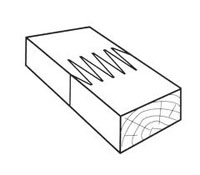|
|
楼主 |
发表于 2012-8-8 17:05:22
|
显示全部楼层
查了一下网上的资料:英文原文见下,翻译大意是:
很多人误以为用整块木材切割的琴头和琴颈比拼接的好,其实这个是错误的认识...
原因是整块木材切割的时候,会按照木材纹理走向切割,由于琴头受到拉力会顺延着木材纹理直达下部,造成在琴颈与琴头过渡部位出现“弱点”
反之,用现代方式拼接的琴头和琴颈会更加牢固。
通常木吉他会使用scarf joint 和 finger joint两种拼接方式,理论上finger joint由于粘合接触面大于scarf joint, 因此会更加牢固。
scarf joint
 scarf joint
scarf joint
finger joint
 finger joint
finger joint
我这款琴头和琴颈部位的连接方式就是finger joint.
原文地址:
http://www.acousticmasters.com/AcousticMasters_Headstock.htm
Jointed headstocks versus solid necks
Guitar necks are either ‘solid’ necks carved from a single block of wood, or they may be built up from several pieces of wood. It's a common misconception that earlier guitars and today’s top of the range guitars, all use solid necks and that this somehow a superior method of construction. This is not the case, since most of the earliest guitars had headstocks made from a separate piece of wood, glued onto the neck. Although carving an entire neck from a solid blank may result in a neck that looks better, it leaves an inherent weakness in the headstock area. This is because the wood blank will be cut with the grain, so the neck itself will have the wood fibres running in parallel along its length, resulting in the strongest possible neck. However, because the headstock angles back from the neck, when the headstock is carved from the same block, the grain runs at an angle across the thickness of the headstock, so there’s a weakness at this point. With a glued headstock cut from a separate piece of parallel grain timber, the wood is once again being used in its strongest fashion. Contrary to what is often thought, a properly constructed glued joint, particularly when made with modern glues, is stronger than the wood around it and of course it makes more economical use of the raw timber. So a multi-part glued neck is in fact superior to a ‘solid’ neck in every respect, except possibly cosmetically.
[ 本帖最后由 MaxMeng 于 2012-8-8 17:55 编辑 ] |
|
